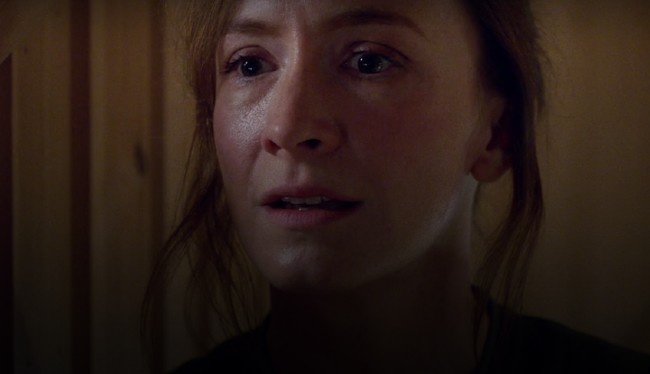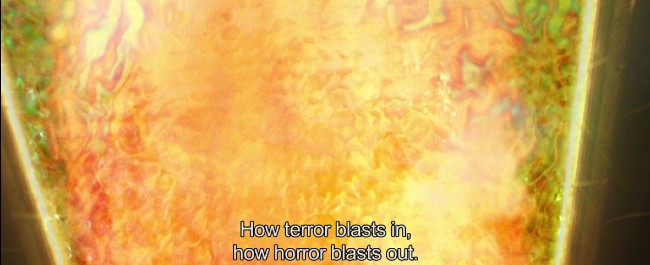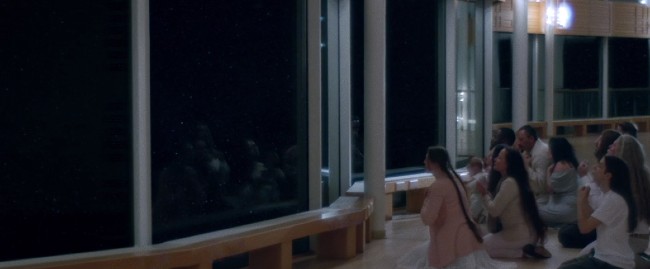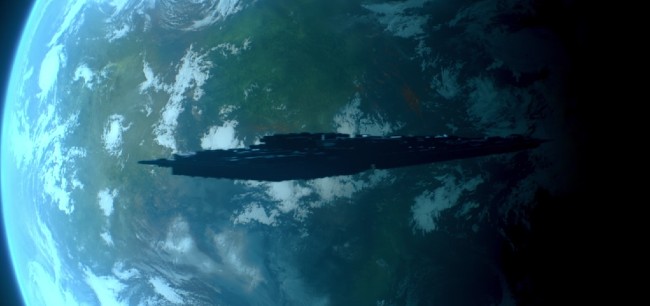Aniara, Science Fiction Five Million Years In The Making

(WATCH OUT. THERE’S SPOILERS FLOATING OUT THERE) Some people have made the argument that we’re in, or have gone through depending on who you ask, a new golden age of television. Others have made the argument that we’re about to witness a golden age of fantasy movies or at least a golden age of fantasy on television. Into these pop culture arguments I would add that we are living in the golden age of the science fiction movie.
The past decade has seen brilliant and thought provoking science fiction movies from Alfonso Cuaron, Christopher Nolan, Ridley Scott, Claire Denis, and James Gray. Largely ignored and overlooked has been Pella Kagerman and Hugo Lilja’s Aniara, a movie that takes five millions years to tell.
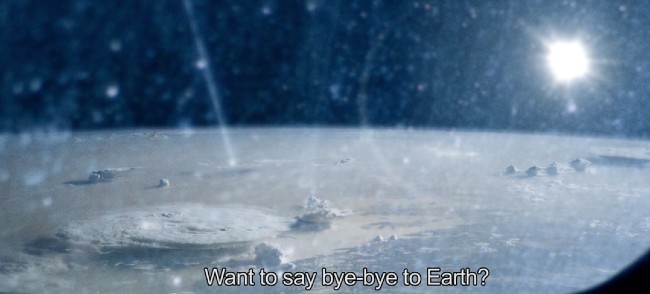
We want our science-fiction movies a couple of different ways. We want a lot of action, we want a happy ending or at least an ending where the hero survives to be in the sequel or we want a combination of the two. Scott’s The Martian combined both with a saccharine sweet ending audiences loved. Any deviation from the tried and true is often meant with scorn.
If there is a formula to the science-fiction movie Aniara throws it out the window. There’s no action to speak of beyond dancing, two sex scenes, and a mysterious rod floating in space being pulled inside the ship. Nothing is being blown out of an airlock. As for the happy ending, there is no happy ending. The hero does not survive. There will be no sequel.
Most movies set in space all have one thing in common. Something goes wrong on or with the ship. An uninvited alien smuggles itself a board, crew members go insane, or a computer starts to do its own thing. Encountering problems, whether external or internal, is almost a space trope. Of course, something has to happen to set the movie in motion. In that sense, Aniara is no different from other science-fiction movies.
When Aniara opens the earth is in its death throes. Uncontrollable fires are scorching the land consuming everything in its path, powerful hurricanes batter the coasts with enough force to topple buildings, and floods are drowning entire cities. Humanity’s only chance for survival is to escape to a colonized Mars. Aniara is the name of the ship taking earth’s refugees to Mars. Yes, something goes wrong.
Shortly after launch a small piece of space debris, a screw to be exact, damages the ship’s reactor, forcing the crew to eject all its fuel, and sending it off course by a few hundred-thousand light years. If there are any similarities between Aniara and other science-fiction set in space it pretty much ends there.
The hero, if there can be said to be a hero, in Aniara is Mimaroben, MR for short. It’s through MR (Emelie Jonsson) we learn of everything that is going on in the ship. MR works for the unnamed corporation that owns and operates the Aniara. Her job is running the Mima. Mima is a super computer of sorts set in a room for passengers to relieve stress and reduce panic. It pulls pleasant, peaceful memories from passengers’ memories and replays them in their mind to momentarily relive better times on earth. It’s like the holodeck from Star Trek: The Next Generation without the detective story adventures.
As time goes by more and more people go to the Mima until one day it, you almost want to call it “she,” decides to quit. Mima has absorbed so many memories, both good and bad, she becomes a sentient being. When she comes to life she decides “There is protection from nearly everything. but there is no protection from mankind.” People mourn her passing like they’ve lost a close friend or a family member. Suspicions turn towards MR who some passengers accuse of “murdering” Mima.
It’s at this point Aniara becomes dystopian for most everyone living on board the ship. Chefone, the ship’s captain, had already set up his own kingdom by the time Mima shuts down. He arrests MR for the “murder” of Mima and then arrests Isagel, the ship’s navigator. Chefone has gone full Colonel Kurtz by the time they’re released from “down there” due to a lack of skilled workers.
It’s also after their release we see how things have gone off the rails in the Aniara. Cults worshiping space and a sex cult worshiping Mima have formed. In times of great trouble people have often turned to religion. The passengers, call them inhabitants after years of living in the ship, are no different from anyone on earth. A lot of the inhabitants have gone the other way to deal with their situation. Suicides increase as the endless voyage continues.
Aniara asks some big life questions like what do you do when your days are numbered? Instinctively, whether we admit or not, we know our days are numbered. However, we have the luxury of living a full and complete life. We can change our scenery, meet new people, and do new things. When you take that all away and you’re surrounded by the same four walls a sense of purpose and life disappears. Aniara asks what would you do in the same situation?
Would you put on a happy face like MR and see the bright side of things even as everything is falling apart? Isagel tells her she always seems happy because the corners of her mouth are always turned up; until she’s not happy and the corners of her mouth turn down. Even then MR doesn’t take the easy way out. Are her actions heroic? It depends on your point of view.
Do you succumb to the dread and the knowing that you and your child will never set foot outside the ship? Isagel, after the sex ceremony in a burned out Mima, has a child. Her disposition becomes worse as her child grows older and the chances of getting to Mars have gone to zero. Her actions may seem extreme, but in light of her current situation can she be blamed?
A typical Hollywood science-fiction movie would want to explain everything that has happened in the movie. James Gray’s Ad Astra was roughly two and half hours with no questions unanswered. Nolan’s Interstellar ran almost three hours and still left the audiences with questions. Leaving an audience with questions is not a bad thing. In fact, some movies are made better by what they don’t say than what they do say.
Aniara has a run time of roughly one-hundred and six minutes, much shorter than the typical movie coming out of Hollywood. The film is broken into chapters of time starting from hours to weeks and ending in years while other chapters have names like The Jubilee, The Yurg, and the penultimate chapter The Sarcophagus.
Most of these chapters are short. However, each chapter contains enough information to inform the viewer what had happened in between the chapters. Kagerman and Lilja know the audience for Aniara is smart enough to fill in gaps and to piece things together that are not specifically stated. In the end there are a few questions left remaining. We are left not wanting to answer these questions so much as dealing with the feeling the movie leaves in the pit of the stomach.
If there is a happy ending it’s knowing that the Aniara made it to the Lyra Constellation and successfully used the gravitational force to turn around. More than five million years later the ship returns to a green, blue earth with clear skies. Five million years without people was all the earth needed to heal itself.
A+

